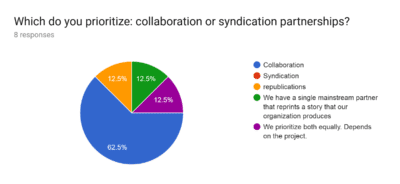What’s Happening:
In the ever-changing news media industry, publishers are constantly trying to stay ahead of the curve on emerging technology, trends and best practices. Nonprofit news outlets, particularly, voice a desire for more knowledge and data-sharing about journalism partnerships.
Why it Matters:
Partnership journalism is a broad umbrella term for two news organizations that partner together to share data or best practices, to promote events or issue awareness, and for collaborative syndication or co-publishing. The latter is of growing interest to nonprofit media.
The nonprofit world, in general, adopts a heavy use of collaboration and partnership models to achieve their missions. For nonprofit news outlets, this collaboration within their journalistic endeavors are highly valued and can lead to more robust reporting. Recently, the Shorenstein Center surveyed eight nonprofit news organizations about the use of partnerships in their work, in an effort to create a baseline for comparison.
The results were classified into two models:
- Collaboration: Projects between at least two organizations that work together on the media. These partnerships can boost reporting and publishing chops with data, reach, and design help.
- Syndication: Where one organizations offers its content for reprint by another organization. This can allow a newsroom can reach a larger audience, extending brand awareness and fulfilling their mission of informing the public.
Digging Deeper:
Five of the eight newsrooms in The Shorenstein study preferred collaboration to syndication, viewing them as a way to extract the most possible value from their small, investigative teams. Seven of the eight newsrooms rated such partnerships with the highest importance for their long-term strategy.
Some of the findings from these newsrooms include:
- The Marshall Project: This nonprofit news organization covering the U.S. criminal justice system has co-published with more than 110 different outlets, and aims to partner for almost all of its media. It mainly seeks out high-profile, legacy institutions that can draw a large, national audience to its investigative features; though sometimes, a regional newspaper is more strategic.
- Center for Public Integrity: This independent, investigative organization covers money in politics, the environment, national security, immigration, workers rights and finance. It does not publish daily, and reports that though it is a modest publisher, it’s growing. They look to partnerships to gain the eyeballs and clout from a mainstream partner, which is important to both their readers and funders.
- The Texas Tribune: This nonpartisan outlet covering public policy, politics, government and statewide issues reported that such partnerships are “baked into” the culture of the company. Distribution partners grab Tribune stories about other Texas cities, freeing their journalists to cover local stories. The Texas Tribune has steadily increased its number of collaborative partnerships, from 18 in 2016, to 23 in 2017, to 35 in 2018.
When it comes to monetizing, Shorenstein saw some sticky issues. Most of the outlets said that they do not charge for content produced for syndication or collaboration, although there are indications that this may shift as the practice grows. Besides lack of monetization, the outlets surveyed also cited the burden of logistics and shared readership data as challenges in such partnerships.
Content from our partners
The Bottom Line:
Audience reach is key in most of these nonprofit news partnerships, with the main aim being to expand brand awareness for their niche issues such as education, the criminal justice system and gun violence. As such partnerships have increased in importance and prominence, The Shorenstein Center has noticed a trend of the word “partnerships” being used in job titles, such as director of media relations and partnerships, and senior director of partnerships.













